Trace in soapmaking marks the moment your oils and lye begin to emulsify, showing the first signs of saponification. You'll notice the mixture thickening enough to leave a visible trail when drizzled across the surface. Different trace stages—light, medium, and thick—offer various opportunities for design techniques. Temperature, oil choices, and mixing methods all affect how quickly trace develops. Understanding these factors gives you complete control over your soap's texture and artistic potential.
Understanding Trace Phase in Natural Soap Oil Production
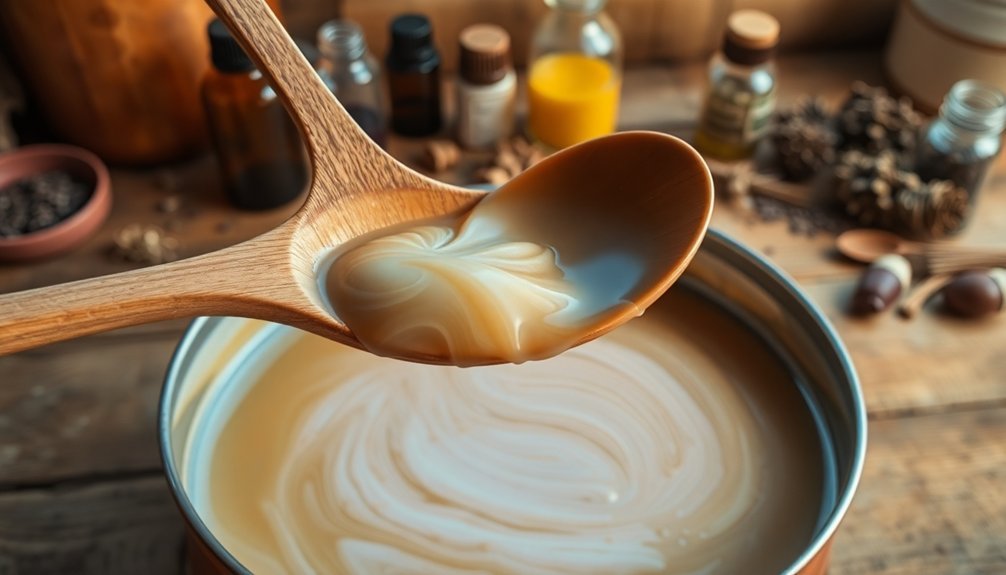
When making natural soap, you'll encounter the vital moment known as the "trace phase" – the point where oils and lye water have successfully emulsified. This milestone indicates that saponification process has begun, transforming your ingredients into soap.
You'll recognize trace when your mixture thickens enough to leave a visible trail or "trace" on the surface when drizzled. It progresses through distinct stages: light trace resembles thin cake batter, medium trace has pudding-like consistency, and thick trace appears similar to heavy custard.
Different oils affect how quickly you'll reach trace. Coconut and castor oils accelerate the process, while olive oil slows it down.
Temperature also plays an essential role – warmer mixtures trace faster, cooler ones give you more working time for complex designs.
What Exactly Is Trace? Defining the Critical Transition Point
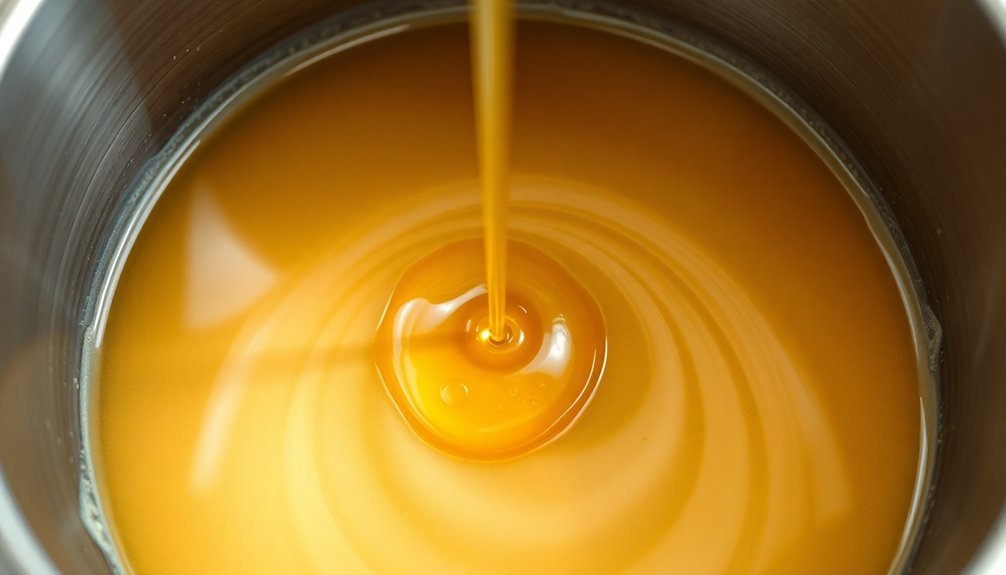
Although many soap makers recognize trace when they see it, understanding its scientific nature provides essential insight into the soap-making process.
Trace marks the pivotal moment when your oils and lye water have successfully emulsified, signaling the beginning of saponification. You'll notice your mixture thickening distinctly, allowing you to drizzle the soap over itself, leaving a visible trail on the surface.
Trace presents in varying consistencies: light (thin cake batter), medium (thin pudding), or thick (thick pudding). Each stage influences how you can manipulate your soap for designs and additions.
Be cautious of false trace, which occurs when your mixture appears to thicken but hasn't truly saponified—often resulting from temperature issues or incompletely melted oils. Recognizing authentic trace guarantees your colorants and fragrances incorporate properly.
Recognizing Different Stages of Trace: From Emulsion to Thick
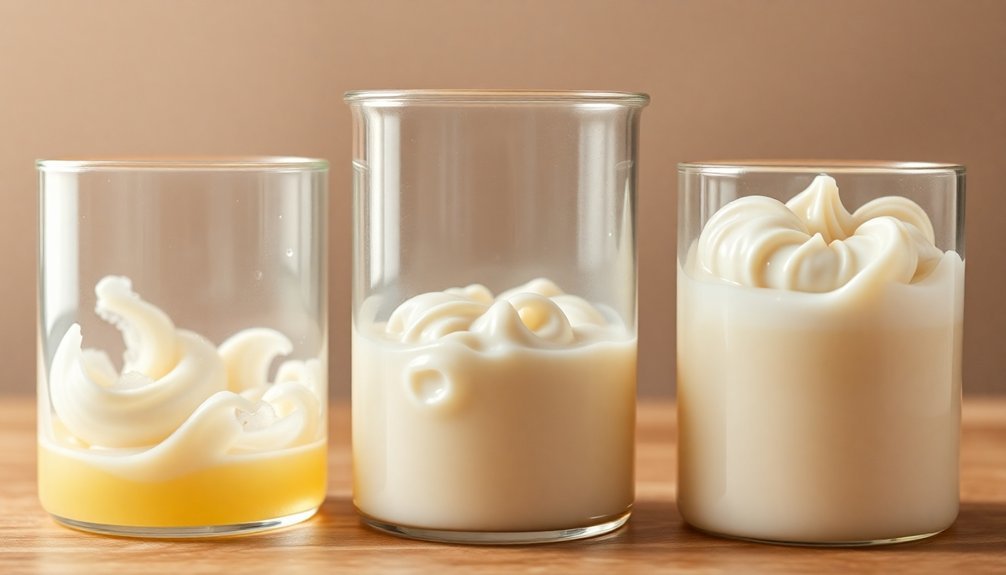
Since successful soapmaking hinges on proper trace identification, mastering the visual and textural cues at each stage becomes essential for crafting quality soap. You'll progress from emulsion—where oils and lye first combine—through increasingly thicker consistencies that determine which techniques you can employ.
| Trace Stage | Consistency | Best Uses | Warning Signs |
|---|---|---|---|
| Emulsion | Barely mixed | Quick pouring | Separation |
| Light | Thin cake batter | Colorants, swirls | Too fluid for layers |
| Medium | Thin pudding | Layering, additives | Sets quickly |
| Thick trace | Holds shape | Textured tops | May be too stiff to pour |
Watch for false trace, which mimics thick trace but hasn't fully emulsified. This temperature-related issue can cause oil pooling if you don't continue blending until achieving true emulsion.
The Science Behind Soap Trace: Chemistry in Action
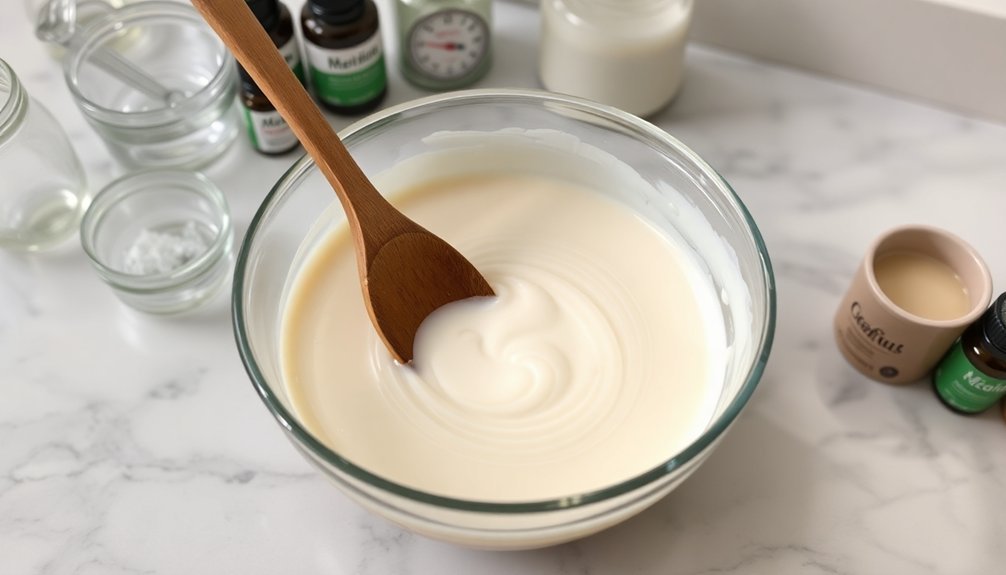
Now that you understand what trace looks like, let's examine what's actually happening at the molecular level. When your lye and oils meet, they trigger saponification—a chemical reaction where fatty acid molecules bind with sodium hydroxide to form soap. Trace is your visual confirmation that this chemistry is actively occurring.
At this vital phase, several factors influence reaction speed:
- Oil composition – Saturated fats like coconut oil trace faster due to their straight carbon chains, while unsaturated oils like olive oil delay trace.
- Temperature control – Higher temperatures accelerate saponification by increasing molecular movement.
- Additive interactions – Fragrance oils and colorants can either speed up or slow down the reaction.
Understanding this chemistry helps you predict trace behavior and avoid false trace, where your mixture appears thick but hasn't properly saponified.
How Botanic Oils Influence Trace Development

Different botanic oils greatly impact your soap's trace time, with unsaturated oils like pomace olive and canola acting as slow tracers, while saturated fats like coconut oil accelerate the process.
You'll notice that temperature plays an essential role too—warmer oils generally reach trace faster than cooler ones, giving you less working time for intricate designs.
Your blending technique matters just as much, as vigorous stick blending speeds up trace development, while gentle hand stirring allows more time to incorporate additives and create swirl patterns.
Slow vs. Fast Tracers
Two primary categories of oils exist in soap making: slow tracers and fast tracers, each behaving distinctly during saponification.
You'll find that oils high in unsaturated fatty acids like pomace olive oil reach trace more slowly, while saturated oils like coconut oil and cocoa butter accelerate the process considerably.
When planning your oil soap recipe, consider these trace behavior patterns:
- Higher oleic acid content typically results in slower trace development.
- Coconut and palm oils are classic fast tracers, thickening your soap batter quickly.
- Essential oils like clove and cinnamon can dramatically speed up trace, regardless of your oil base.
Temperature Affects Acceleration
While crafting cold or hot process soaps, you'll notice that temperature plays a crucial role in how quickly your soap batter reaches trace. Higher temperatures greatly accelerate the saponification process, especially when working with botanic oils containing unsaturated fatty acids.
You'll find that keeping your oils and lye solution between 100-110°F gives you more control and working time. This temperature management is particularly important when using oils like olive or sunflower, which naturally trace more slowly than coconut or palm oils.
If you're incorporating detailed designs or swirls, this temperature control becomes even more critical.
Be aware that certain essential oils like clove and cinnamon can unexpectedly speed up trace. Botanic oils rich in oleic acid or natural sugars, such as avocado and olive, provide longer working windows even at slightly elevated temperatures.
Blending Techniques Matter
Beyond temperature control, your mixing method greatly impacts how quickly your soap batter reaches trace. Alternating between hand stirring and stick blending can dramatically affect trace speed—what might take hours manually can be achieved in just 1-2 minutes with a stick blender.
Your choice of botanical oils and their ratios creates a foundation for predictable results:
- Oils with high unsaturated fatty acid content (like pomace olive oil) accelerate trace compared to saturated alternatives.
- Experimenting with oil ratios gives you control—higher percentages of slower-tracing oils extend working time.
- Strategic additive timing matters—add fragrance oils or clays at light trace if they're known to cause rapid thickening.
Master these blending techniques to create the perfect canvas for your soap artistry.
Essential Techniques to Slow Down Accelerating Trace
When your soap batter begins to thicken too rapidly, you'll need strategic interventions to maintain control of the process.
Opt for olive oil over coconut oil in your formulation, as faster-moving oils can dramatically accelerate trace. Avoid excessive water discount by maintaining a 1:1 water-to-lye ratio, which gives you more working time before the mixture solidifies.
Your stick blender can be your worst enemy during soap making—use it sparingly or switch to hand stirring when you notice the batter beginning to thicken.
Keep your temperatures modest (100-110°F) to slow the exothermic saponification reaction. For best results, add potentially problematic fragrances and essential oils only after achieving light trace to prevent sudden acceleration and preserve your design opportunities.
Temperature Management for Optimal Trace Control
Since temperature directly affects the speed of saponification, mastering heat control is essential for predictable trace development. By maintaining oils and lye solutions between 100-110°F, you'll greatly slow the saponification process, giving yourself more working time for complex designs.
- Avoid external heat sources during mixing, as they accelerate trace and reduce your window for creating intricate patterns.
- Monitor your stick blender usage, using short bursts to prevent unnecessary heat generation that could lead to false trace.
- Consider your oil choices carefully—incorporating slow-moving oils like olive oil extends your working time before reaching trace.
Effective temperature management isn't just about cooling—it's about maintaining consistent conditions throughout your soap-making process.
When combined with appropriate water-to-lye ratios (ideally 1:1), you'll gain remarkable control over your trace development.
Tools and Mixing Methods That Affect Trace Timing
The tools you choose and how you use them can dramatically alter your soap's trace timeline, giving you either minutes or hours of working time. Your mixing method notably impacts how quickly your soap reaches trace.
| Tool | Effect on Trace Timing |
|---|---|
| Stick Blender | Achieves trace in 1-2 minutes with powerful emulsion |
| Manual Whisk | Allows hours of working time with better control |
| Combination Method | Short blender bursts plus hand stirring prevents over-thickening |
| Temperature Control | Higher temps accelerate trace; cooler extends working time |
| Oil Selection | Slower-moving oils like olive oil extend trace for detailed designs |
For intricate soap designs, consider using manual mixing methods or the combination approach. You'll maintain better control over the soap's consistency while avoiding the rapid thickening that stick blenders can cause.
Common Accelerants and How to Counterbalance Their Effects
Beyond your mixing tools, various ingredients themselves can dramatically alter your soap's path to trace. Certain essential oils like clove and cinnamon are powerful accelerants, as is coconut oil with its highly exothermic saponification reaction.
When formulating recipes, you'll need strategic counterbalancing techniques.
- Incorporate higher percentages of slower oils like olive oil to extend your working time
- Increase your water-to-lye ratio to slow down the chemical reactions
- Maintain lower temperatures for both your oils and lye solution
Remember that sweeteners such as honey and fruit additions also speed up trace considerably.
Troubleshooting False Trace vs. True Saponification
Many soapmakers encounter false trace during their soap-making journey, often mistaking it for true saponification and prematurely pouring their soap into molds.
To identify false trace, watch for a mixture that appears thick but separates later. True saponification creates a stable emulsion where the mixture holds its shape when drizzled.
Always verify your oils are completely melted before combining with lye to prevent uneven reactions.
Temperature management is critical – cooler temperatures generally extend trace time, giving you more working time and reducing false trace risk.
After pouring, perform a zap test after 24 hours to confirm proper saponification; true soap won't produce a lye burn sensation.
Mastering Trace for Advanced Design Techniques
To create stunning soap designs, you'll need to recognize the precise trace moments when your soap batter is ready for different techniques—light trace for delicate swirls, medium for layering, and thick for textured tops.
When your swirl patterns blur together or your layers blend unexpectedly, you're likely working with too light or too heavy a trace for your intended design.
Maintaining consistent temperature throughout your soaping process prevents accelerated trace, giving you the working time needed to execute complex patterns while ensuring proper saponification.
Identifying Perfect Trace Moments
When exactly should you add colorants or attempt swirl designs? Recognizing the ideal trace moment is essential for successful soap designs.
Light trace provides the perfect consistency for colorants and fragrances, while medium to thick trace works better for textured tops and intricate patterns.
Your oil selection directly impacts trace speed—coconut oil accelerates trace, while olive oil slows it down. Managing your stick blender technique gives you greater control; alternate between blending and hand-stirring to maintain your desired consistency.
- Light trace: Batter leaves faint trails on the surface; ideal for complex swirls and layering
- Medium trace: Consistency similar to pancake batter; perfect for drop swirls
- Thick trace: Pudding-like texture; best for textured tops and embeds
Temperature management remains vital—cooler temperatures slow emulsification, giving you more working time.
Swirl Pattern Troubleshooting
Even the most experienced soap artisans encounter swirl pattern challenges when the trace stage doesn't cooperate with their artistic vision.
When your designs aren't turning out as planned, consider your oil selection first—incorporate more olive oil to extend working time before trace develops.
Temperature management is vital; cooler oil and lye mixtures slow trace development, giving you more control over intricate designs.
If you're still struggling, adjust your water-to-lye ratio for a more predictable consistency.
Remember to add colorants and fragrances at light trace to prevent premature thickening.
For successful swirls, you'll need that sweet spot between too thin (patterns won't hold) and too thick (can't pour smoothly).
Through experimentation with different oil combinations, you'll soon master the balance needed for those picture-perfect swirl patterns.
Temperature Control Essentials
Successful soap designers recognize that temperature management forms the cornerstone of controlling trace development during the soap-making process.
By maintaining oils and lye around 100-110°F, you'll considerably extend your working time before the mixture thickens. This temperature control directly impacts how quickly your soap batter reaches trace, giving you the opportunity to create complex patterns and designs.
- Opt for a 1:1 water-to-lye ratio to slow trace speed and prevent premature thickening
- Choose slow-moving oils like olive or sunflower to maximize design time
- Switch to manual mixing instead of stick blenders for better trace observation and control
Remember that external heat sources and sugar-based additives can dramatically accelerate trace, so monitor your workspace temperature alongside your ingredients for consistent, predictable results.
Frequently Asked Questions
What Is the Trace Stage in Soap Making?
In soap making, trace is when your mixture thickens as oils and lye emulsify, signaling saponification has begun. You'll notice it's reached a pudding-like consistency that can hold its shape when drizzled.
What Happens if Soap Doesn't Come to Trace?
If your soap doesn't reach trace, you'll face separation issues, unsaponified lye that can irritate skin, and unstable mixtures. You won't achieve proper emulsification, making it difficult to add colors or fragrances effectively.
Why Does My Soap Trace so Fast?
Your soap traces fast likely due to high unsaturated oils, coconut oil content, fragrance oils with cinnamon/clove, hot temperatures, or excessive stick blender use. Try cooler temperatures and less aggressive blending to slow it down.
What Causes False Traces in Soap Making?
False trace happens when your hard oils solidify before properly reacting with lye. You'll see a deceptive thickness that's not true saponification. It's usually caused by low temperatures or inadequate mixing of your ingredients.
In Summary
You've now mastered the elusive trace phase, a critical milestone in your soap-making journey. By understanding the chemistry, recognizing true trace indicators, and adapting your methods to different oils, you'll confidently control this transformation. Whether you're aiming for light trace for intricate designs or thick trace for textured tops, you're equipped to create natural soaps with precision and artistry.

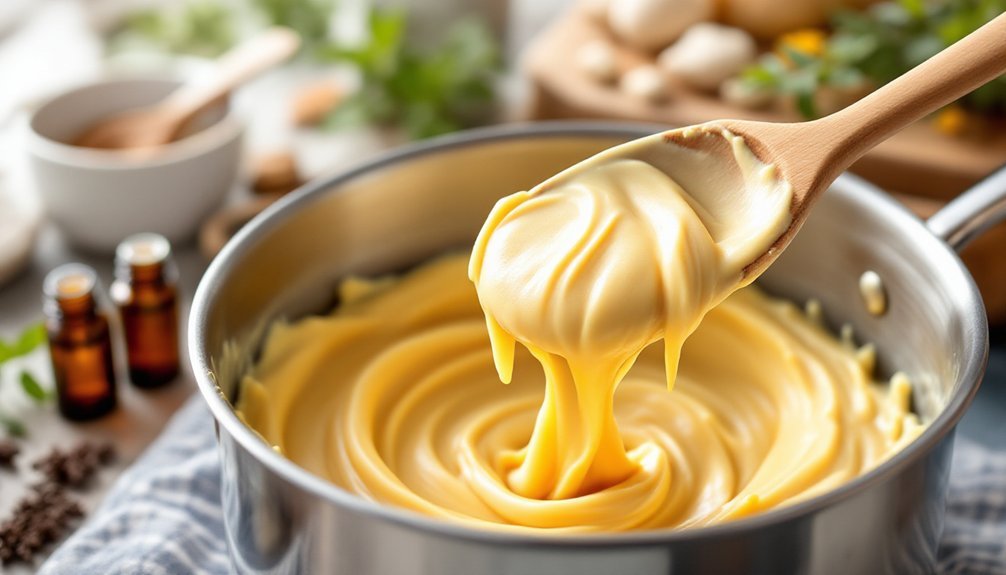
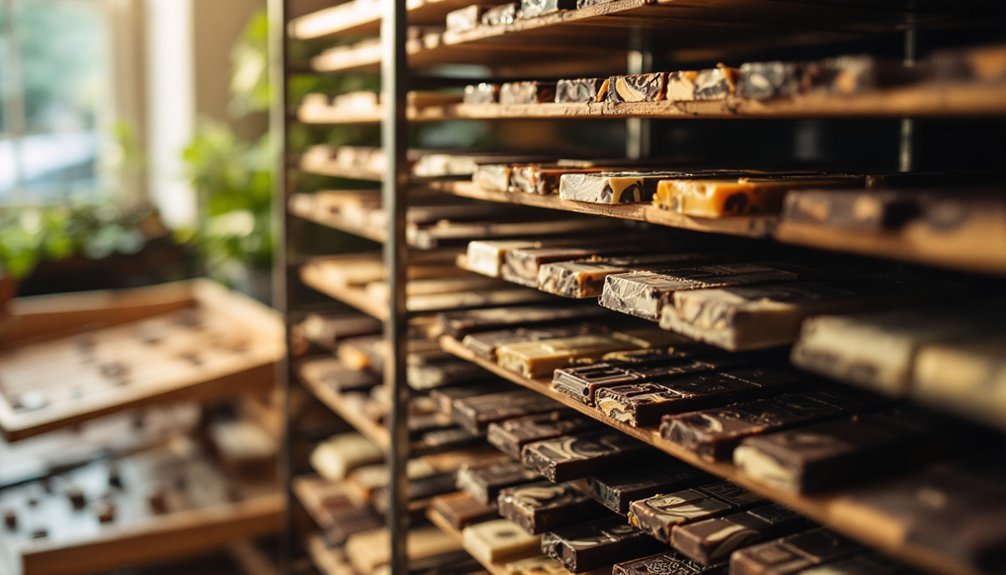
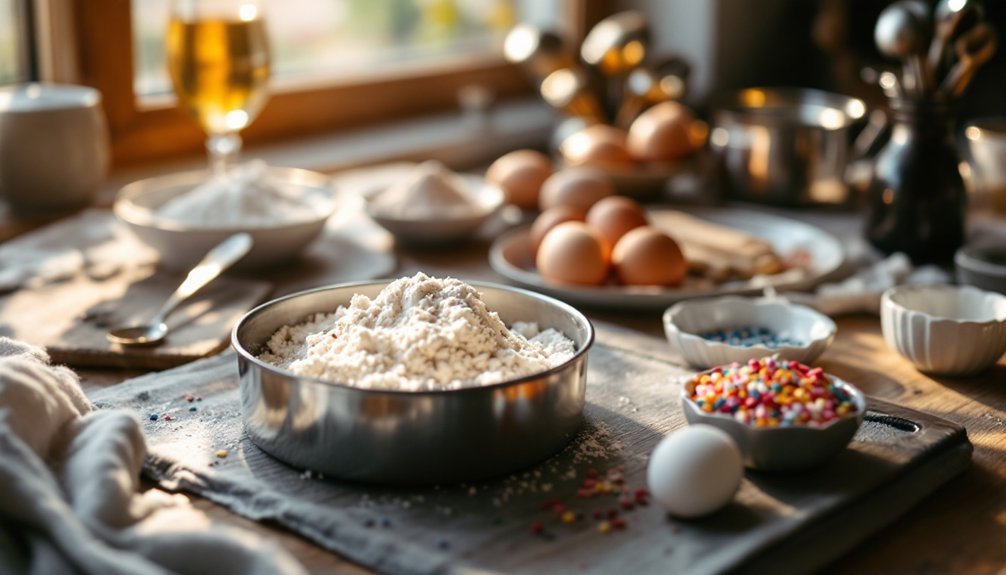
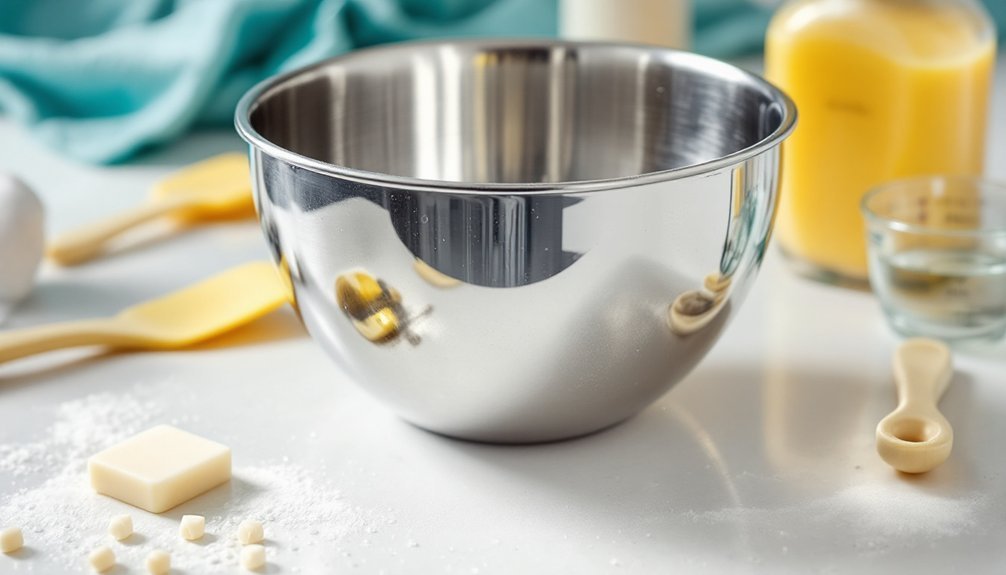
Leave a Reply